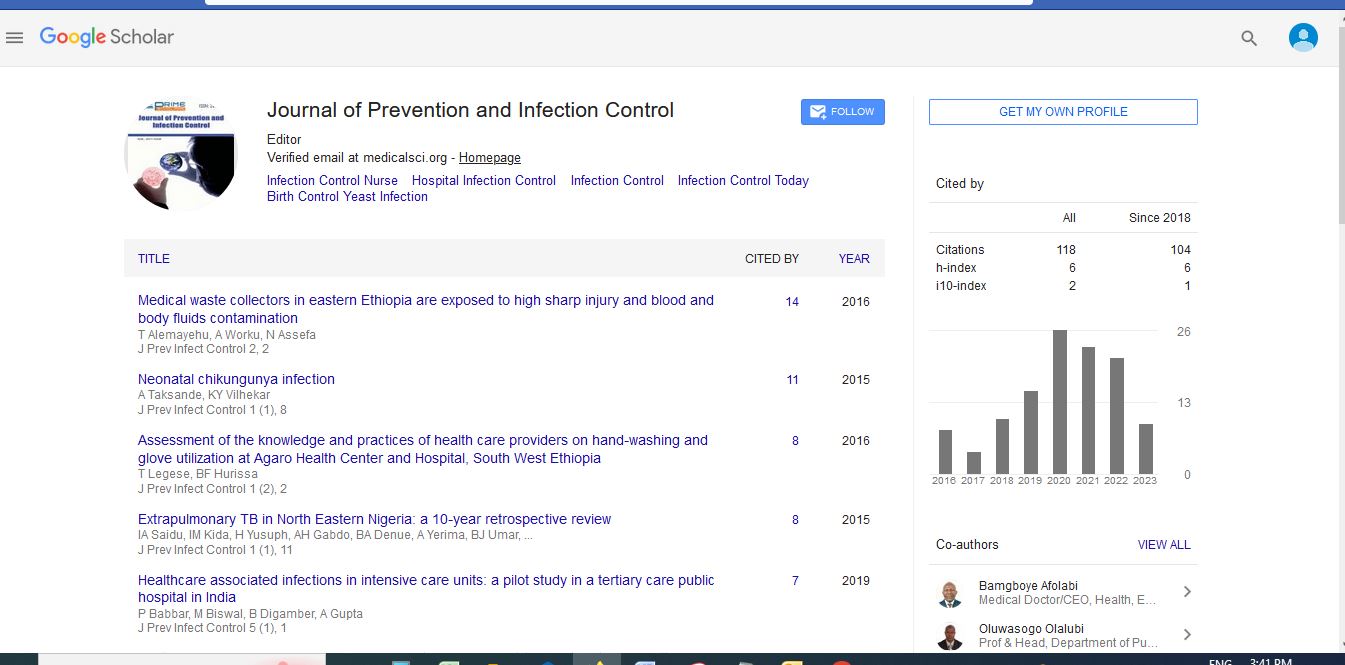Short Communication - (2024) Volume 10, Issue 4
Preventing Infections: Best Practices for Effective Infection Control
Elijah Martinez*
Department of Infection Prevention and Control, University of California, United States
*Correspondence:
Elijah Martinez,
Department of Infection Prevention and Control, University of California,
United States,
Email:
Received: 02-Dec-2024, Manuscript No. IPJPIC-25-22454 ;
Editor assigned: 04-Dec-2024, Pre QC No. IPJPIC-25-22454 (PQ);
Reviewed: 18-Dec-2024, QC No. IPJPIC-25-22454 ;
Revised: 23-Dec-2024, Manuscript No. IPJPIC-25-22454 (R);
Published:
30-Dec-2024, DOI: 10.36648/2471-9668-10.4.31
Introduction
Infection control and prevention are critical components of
public health and healthcare settings. The spread of infectious
diseases poses significant risks to individuals, communities,
and healthcare institutions. By implementing effective infection
control measures, we can reduce the risk of transmission and
protect both patients and healthcare workers. This article
explores key concepts, strategies, and best practices for
preventing infections and controlling their spread. Infections
occur when harmful microorganisms such as bacteria, viruses,
fungi, or parasites invade the body and cause disease. These
microorganisms can spread through various means, including
direct contact, airborne transmission, and contaminated surfaces.
Infections spread through several key routes. Direct contact
with an infected person or indirect contact with contaminated
objects. Respiratory droplets from coughs, sneezes, or talking can
spread infections. Microorganisms that remain suspended in the
air for extended periods can infect individuals who inhale them.
Infections transmitted through insects like mosquitoes (e.g.,
malaria, dengue). Ingesting contaminated food or water can lead
to diseases like cholera. Hand hygiene is the most effective way
to prevent infections. Proper handwashing with soap and water
or using alcohol-based hand sanitizers reduces the spread of
pathogens. The World Health Organization (WHO) emphasizes
the â??Five Moments for Hand Hygieneâ?. Before touching a patient.
Before clean/aseptic procedures. After body fluid exposure risk.
After touching a patient. After touching patient surroundings
[1,2].
Description
PPE provides a physical barrier against infections and includes
gloves, masks, gowns, and face shields. The appropriate use of PPE
depends on the level of exposure risk and the type of infection.
To prevent respiratory infections to cover your mouth and nose
with a tissue or elbow when coughing or sneezing. Dispose of
tissues immediately. Wear masks when necessary, especially in
healthcare or crowded settings. Surfaces and medical equipment
can harbor pathogens. Regular cleaning and disinfection of
high-touch areas such as door handles, bed rails, and medical
instruments help prevent infection spread. Unsafe injections
can lead to the transmission of bloodborne diseases like HIV and
hepatitis. Using sterile needles and syringes for each patient is
essential for infection control [3,4]. Proper disposal of medical
waste, including sharps, biological materials, and contaminated
items, is crucial to prevent infections. Biohazard waste should
be handled according to established safety protocols. Patients
with contagious infections should be isolated to prevent
disease transmission. Cohorting, or grouping patients with the
same infection, can help reduce cross-contamination. Vaccines
are one of the most effective tools in preventing infectious
diseases. Immunization programs help protect individuals and
communities against preventable illnesses such as influenza,
measles, and COVID-19. The misuse of antibiotics has led to
antibiotic resistance, making infections harder to treat.
Conclusion
Healthcare professionals should prescribe antibiotics judiciously
and educate patients on completing their prescribed courses to
prevent resistance. Infection control programs should include
ongoing monitoring of infection rates and outbreaks. Surveillance
helps identify emerging threats and implement timely
interventions. Hospital-acquired infections occur in healthcare
facilities and can be life-threatening. Common HAIs includes
Urinary tract infections (UTIs), Surgical site infections (SSIs),
Pneumonia, Bloodstream infections (BSIs). Healthcare facilities
follow infection control guidelines that includes basic infection
control practices applied to all patients. Additional measures
based on the mode of infection transmission (contact, droplet,
airborne). Healthcare workers play a vital role in infection control
by adhering to hand hygiene practices. Properly using PPE.
Following cleaning and disinfection protocols.
Acknowledgement
None.
Conflict Of Interest
The author declares there is no conflict of interest.
References
- Anziano RJ, Milligan PA (2021) Model informed drug development: Collaboration through a common framework. Clin Pharmacol Ther. 110(5):1165-1167.
[Crossref] [Google Scholar] [PubMed]
- Zvirblis P, Ellin RI (1976) Acute systemic toxicity of pure dimercaprol and trimercaptopropane. Toxicol Appl Pharmacol. 36(2):297-9.
[Crossref] [Google Scholar] [PubMed]
- Zhu H (2020) Big data and Artificial Intelligence modeling for drug discovery. Annu Rev Pharmacol Toxicol. 60:573-589.
[Crossref] [Google Scholar] [PubMed]
- Schmidt EW, Lin Z (2022) Translating marine symbioses toward drug development. mBio. 13(6):e0249922.
[Crossref] [Google Scholar] [PubMed]
Citation: Martinez E (2024) Preventing Infections: Best Practices for Effective Infection Control. J Prevent Infect Control. 10:31.
Copyright: © 2024 Martinez E. This is an open-access article distributed under the terms of the Creative Commons Attribution License, which permits unrestricted use, distribution, and reproduction in any medium, provided the original author and source are credited.

